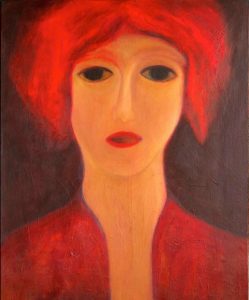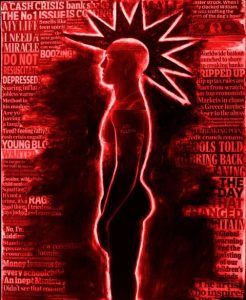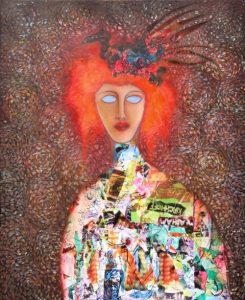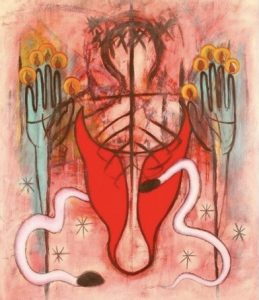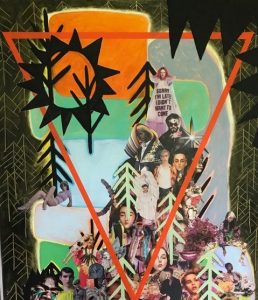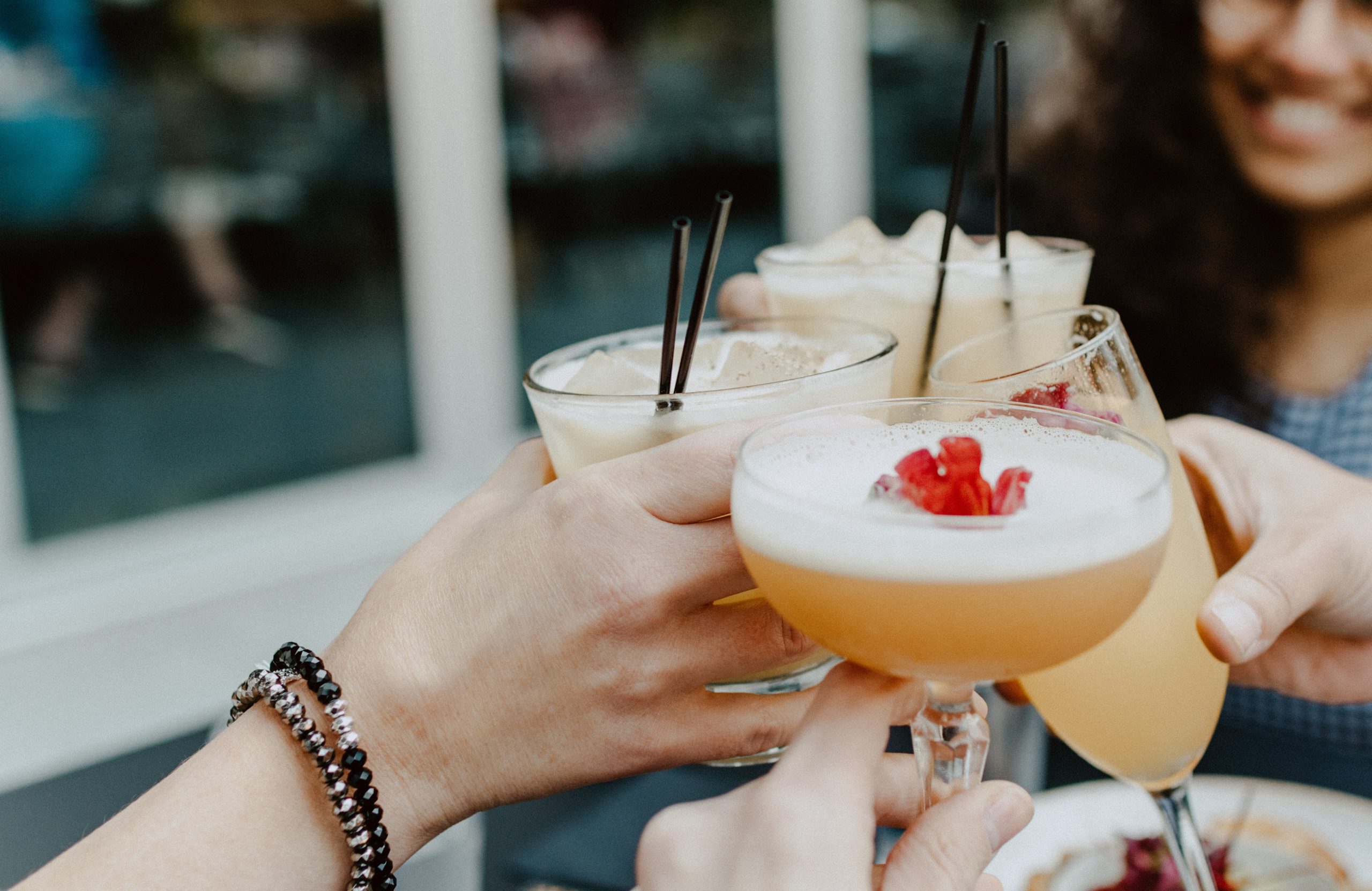The art of Robert Kyle can be described in many ways – it may be simply different to some, while dark and perhaps even upsetting to others. However, I find it moving, haunting, and always telling the story of an artist who’s seen the highs and lows of life and has lived to share his life-affirming journey. Diagnosed with a debilitating condition in his mid-30s, at the height of his career, he changed gears and decided to show the world his captivating inner universe. And now we’re all paying attention.
What defines you, as an artist? Who are you?
Robert Kyle: My art is linked to my dreams, hopes, ideas and self-exploration while living in the post-truth, digital revolution of modern life. Art has always been a mirror that’s held up to reflect the society we live in, which is currently a difficult place of vast inequalities and the looming dangers of climate change. To live facing these issues, I felt that I needed to find a strong place of knowing who I was. This process of understanding life can only come through a deep exploration of the self.
My work is infused with a journey you could call spiritual – this is not something I play around with, it’s something I take very seriously. For me, the natural world is a great source of comfort, it feeds me and allows me to explore deeper questions about life. I’ve always been interested in indigenous spiritual beliefs, folklore, old rituals, and traditions that connect us to the land and ancestors.
In other cultures, a person who explores this otherworldly landscape is the shaman, a person who knows how to speak with the forces of nature. I’ve spent time with these people, learning traditions that have helped me find my place in the world. My art emerges from these journeys, coming from those quiet spaces that allow inner visions to emerge. Every artist in a way is connected to the shaman, it’s the act of bringing forth ideas and images into the world that creates a journey that becomes the art.
For me, art is the creative expression of life, the process of making art is an alchemical mixing of ideas, visions and the will to bring forth something into the world, you could say it’s an act of magic. It creates something out of nothing that can be displayed for others to find some transformative meaning within it.
Great art touches the soul, I remember seeing Rothko for the first time, it was a transformative experience. I sat looking, and through the simple act of being present in front of those colour fields, I felt myself shift out of ordinary life into a more profoundly expansive state. I didn’t want to possess the art or have a need to have it on my wall. I just was in awe at how it transformed me inside, it made me experience something other than my daily consciousness.
When art such as this acts as a catalyst for change, then for me it’s an act of magic, it has cast a spell over the observer and something shifts inside, opening up other perspectives, new horizons. The art itself becomes a doorway for individual journeys that can elevate us outside of the day-to-day world, and this can be only a good thing – as to transcend our earthy condition and experience something more is a true act of rebellion.
Your story is… well, the story of a life. I was moved by your past struggles and your incredible strength to overcome them and shine through your art. Tell us what in your past inspired your pieces.
Robert Kyle: When I was 37, I had a successful career in television as a costume designer, overnight that finished as I became unwell with a condition called Chronic Fatigue Syndrome. This left me unable to work, unable to do all the things people take for granted and very quickly my world became very small. It’s funny what you hold onto when you’re facing such difficulties, my way of coping was to retreat into a rich internal world of imagination that eventually found itself emerging as a body of art.
Many of my pieces reflect humanity, capturing moments of emotion that can come when dealing with the suffering world. Strength comes when you can hold onto something you believe in, this internal world of visions was as real as the world we experience in day-to-day life, for me, these rich colours and vivid expressions all became a way of processing what I experienced through coping with long-term chronic illness.
When I think about the struggles I’ve faced, having a sense of empathy makes me understand that we’re all coping with the same things that come from challenges. For me, it was a long-term illness, for others it’s depression, anxiety, the battles with self-worth and the constant internal dialogue we all have that can chip away at our sense of self-belief.
What gives me strength to cope with all these things is a strong conviction of knowing that what comes through me is a connection to a place of trust. Being able to hold onto that in the face of life’s difficulties, allows for a conduit to be open that brings forth images that would be only ideas and visions if left inside. This trust allows me to make art, the process of actually creating is an act of surrender, I accept that what comes through me are images that need to have a presence in the world.
How do you engage with your audience and what do you want them to see in your creations?
Robert Kyle: I’ve had a couple of exhibitions on Vyner Street in London, both attracted a good crowd of people at what was The First Thursday in the month art event. But since then, I haven’t shown my work because of the difficulties that come with finding a gallery. I’ve heard that what makes a successful artist is someone who makes art and then has the ability to turn it into a business, to be able to sell it to others, something I confess I’m not very good at.
A lot of creative people enjoy the act of making work, but when it comes to turning it into a product to sell, this becomes something they find hard to do. All good creators have always had a collaborator, look at Yves Saint Laurent who flourished with his partner Pierre Berge, they each understood their strengths and together made something that could be sold commercially.
My work speaks to people in different ways. What it initially meant for me while working on it might be very different for those looking at it. This is the power of art, it can be a gateway to many things. Making art is like creating a ritual, you bring to the space objects and materials that become transformed through the process of action.
What you set out to do often takes you in a completely different direction, the more you get out of the way, the easier it is for the work to speak. It’s a dialogue you set up with something bigger than the limited self. By acts of surrender, images can come through that have their own voice.
I always know when a work is finished. I feel it, there’s this sense of deep completion, some work comes out like wildfire, it burns so intensely that it can leave me exhausted.
Others take time, in some cases even years before they come to be finished. What I want people to see in the art is the journey that makes the work, whatever else they see is an individual experience that can only be explained by the person viewing it.
Tell us about your choice of media and what it means for your work. There’s so little discussion in the art space about sustainability when, really, it should be at the top of everyone’s mind. Tell us your thoughts on that.
Robert Kyle: Most of my art is made from mixed media, I’ve used a lot of collage in my work. Over the years, I found that I’d collected many magazines. I don’t buy these anymore because of our need to be more sustainable and everything I need is online these days. I didn’t like the idea of throwing them away, it felt wasteful, so I incorporated them into my work.
As an artist, you use what’s around you, stuff you find. I often work on two pieces at the same time, one I explore with my active mind, while at the same time I like to work on another which is created in a more reflective space. These two ways of working complement each other and can produce very different images that come from different aspects of the mind.
When it comes to sustainability, this is the hot topic of the moment. Everything we do needs to be conscious around the issues of the clothes we buy, the flights we take, whatever we consume needs to have an awareness attached to it. I haven’t seen many artists dealing with these issues yet, the world seems to be still caught up in celebrity lifestyles and consumerism. A few people are forging ahead with new ideas, but still far too many are stuck in an old paradigm.
We need to understand our carbon footprint, much of the world is caught up so tightly with capitalism that people can’t see another way. Things have to change, and it’s through the voices of artists that that change is often first articulated.
I remember growing up in the 80s, there was more grassroots sustainable creativity and activism back then, people made and customised their own clothes, music felt raw and immersive, you felt like you could be a part of something. Today we’ve all been assimilated into brands, brands of clothing, brands of music, which translates ultimately to the brand of money.
That rocket ship took off in the early 90s and we’ve been riding it ever since – this is what I believe had led to the deep divisions we now see in our world. There’s a great quote by the writer William Burroughs who said, ‘what does the money machine eat? It eats youth, spontaneity, life, beauty and above else it eats creativity. It eats quality and shits quantity.’ That about sums it up
If we’re to be very honest, it’s not the everyday person who has the biggest carbon footprint, it’s the wealthy elite, and the problem we face now is they don’t want to give up their lifestyles. I suppose I’m becoming a bit political in my views, but you can’t take politics out of life because the two are the same faces of the same coin.
What I loved about the era I grew up in was a sense of strong voices that challenged the establishment with clothes, music, film and art. The films of Derek Jarman, the clothes of Vivienne Westwood and the alternative music scenes created legacies that last to this day. I’m certainly not looking back with rose-tinted glasses; life was hard, but there was a sense that grassroots creativity could flourish and create platforms where many of these problems could be discussed.
I’m hoping that the issues that face us are going to be explored more creatively by the upcoming generation who are more switched on. The problem comes with trying to get voices out there – with rocketing rents, food, bills and a social safety net that is threadbare, it leaves a lot of young people struggling just to survive.

The issues of climate change and inequality need to be embraced by everyone because the challenges that are coming are going to impact all levels of society. All this has to be explored through cultural narratives to bring about a deeper understanding of the need for systemic change. I’m not saying my work is an act of activism, but it does hold within it some of my own views about the world we currently live in and hopefully it reflects some ideas back.
If you were to give one piece of advice to an artist trying to find their voice, what would that be?
Robert Kyle: Never compromise your vision, your authentic voice is what counts, when you’re asked about your work speak your truth, never make stuff up, always be authentic to yourself, that way people will hear you. Truth, honesty and kindness go a long way.
How should someone pick the art that they bring into their homes? What art do you have in your home?
Robert Kyle: Buy art that has an emotional connection for you, that way it will always going to sing to you. Listen to your inner voice, not the one in your head, the one in your gut, that’s the authentic voice that always speaks truth. People desire things because of the emotional connection they have from seeing them.
The eyes are powerful gateways to our emotions and it’s through these doors that we explore art, it catches our attention, and for a while we stop and look. This simple act, just looking, brings us close to our humanity and opens up within us a connection that is often hard to explain in words. I would always recommend buying art on these sets of values rather than buying just for pure investment.

My home has a collection of things that have spoken to me over the years, each piece tells a story. I really love folk art, there’s something in the naïve potency of images that often connect directly to people who lived closely with the land. I have a painting of a Scottish woman which was done in the year 1815, the year before the poets Byron and Shelley met at the Villa Diodati on the shores of Lake Geneva. She’s wearing an empire line dress, the sky behind is dark, fraught with a gothic atmosphere that pervaded the era.
Even now, more than two hundred years later, this painting still tells a story of a world of changing politics and radical ideas. I also have a few of my own works on the wall, they remind me of the time when it was made and how those moments still remain within me. I’m a very visual person so I like to look at things, I like to surround myself with objects that have a story attached to them, that way they create a sense of contemplation.
What would you like your legacy, as an artist, to be?
Robert Kyle: That I explored life with a curious mind, and through that journey came art and writing that reflects the creative aspect of my life. Life isn’t easy, it takes courage to live it, you have to open yourself to ideas and people that might be very different from your own. What counts is how we navigate it well, how we can find places where we can communicate our truths in ways that help us to understand each other.
There’s a lot of suffering right now in the world, I would hope that as an artist I’ve been able to explore some of these challenges I’ve faced in my own life. I don’t have any grandiose ideas of leaving any great legacy, if I can live my life in a way that’s helped others, been kind to people and offered support where I could, then that’s enough.
We live in a world where everyone’s clutching after success, wanting more and more, wanting to be seen in the right places with the right people, doing the right things. But more often than not this is just exhausting, the best place to be is comfortable with yourself and right now I would say I’m more than happy with who I am.
If my work outlives me then great, but if it’s forgotten that’s ok as well. It’s been the act of being able to make it that produced the great gift, because through the process I discovered many aspects of myself that otherwise would’ve laid hidden. I will leave here one final thought from the French philosopher Albert Camus. “Sometimes carrying on, just carrying on, is the superhuman achievement.”
Follow Robert on Instagram or visit his website for more of his work.




